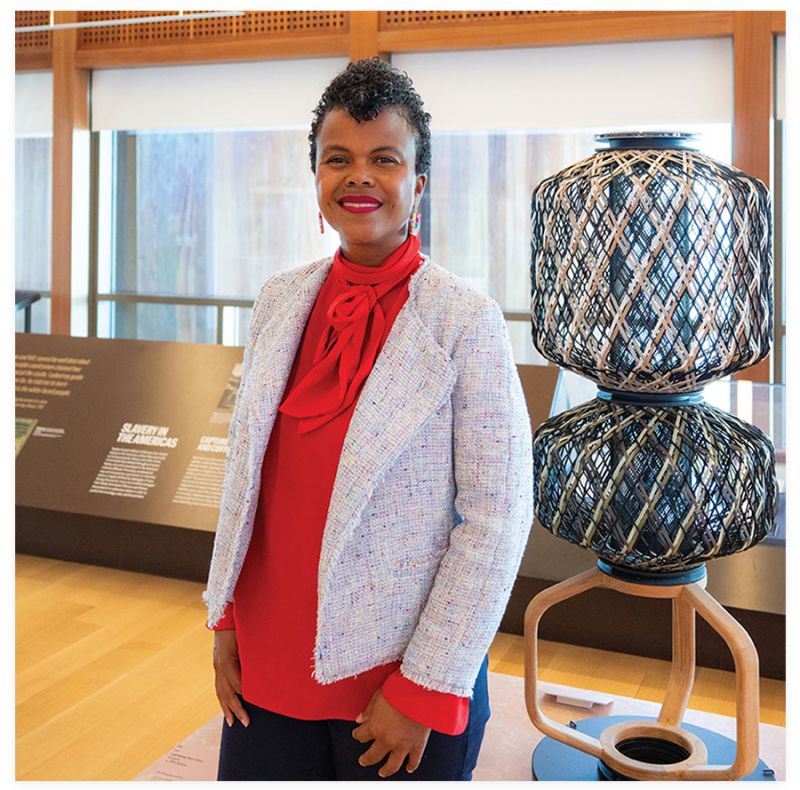A new partnership with school districts will allow local students to take free field trips to the musuem for free

Lives: West Ashley
Education: University of Michigan, Wayne State University Law School
Career: Charles H. Wright Museum of African American History in Detroit, National Art Gallery of The Bahamas, Detroit Historical Society, IAAM
Family: Mother of five children
Hobbies: Kickboxing and CrossFit at RockBox Fitness; “It is not an extracurricular activity. Fitness is food, and a girl’s got to eat.”
What she’s reading: I Hope You Fail by Pinky Cole
As the chief learning and engagement officer of the International African American Museum (IAAM), Malika Pryor manages six teams that are behind the exhibits visitors see, the words they read, and the programming offered at the institution, which began welcoming visitors in June 2023. In January, Pryor helped launch a partnership with local school districts that eventually will allow every fourth, eighth, and 11th grader to visit the IAAM with their class for free. The curator came to Charleston in July 2022 with leadership experience in three museums, including in her hometown of Detroit and in the Bahamas. Here, Pryor shares why she’s so passionate about the everyday decisions that go into creating the museum experience.
CM: You worked in the Bahamas before you moved to Charleston. How did that experience help prepare you for this position?
MP: Living abroad helped me to value the import of quiet, the power of being a listener, and not showing up with the expectation that I’m a museum person—I’ve done this before, I’ve lived in these other places, and therefore I have an understanding. No, no, no. Every place is its own place, and it was important to me to understand my place as a cumya [Gullah for people who have come here], to be respectful of what it means to learn, and have an understanding of folks’ perspectives.
CM: What are you most proud of so far?
MP: There was a day when I walked into the museum, and every single wall was filled, all the tech was in, the systems were working, the air was cool and sufficiently dry with just enough moisture to ensure the proper preservation of the artifacts, the special exhibition was in, and it was just absolutely real. And I knew the details—the long days, the long nights, the tears, occasionally blood, the sore muscles, and the tired brains that still managed to bring forth incredible brilliance, and through pivot after pivot after pivot, remained committed to what it would look like to get this place to where it could be open to the public. As the first visitor walked through (and I was fortunate enough to be at our front doors when that took place), she was holding a handkerchief, because she had already begun to tear up. While I’m sure her personal history and her awareness of the significance of the space moved her, what I also knew was that it was those long nights, those weekends worked, those tired brains that managed to manifest perfect brilliance, collectively, that summoned those tears and that was worthy of them.
CM: What other feedback have you received?
MP: The reaction most commonly shared is, “I need more time, I have to come back.” From an emotional space, folks feel full, inspired, and empowered. I often say this is a museum that is perpetually sharing stories that live at the intersection of incredible trauma and also incredible joy. That can be hard to process. But the museum itself, the way in which it’s constructed, the way in which exhibitions were designed, and the way in which the facility was conceived by [architect] Pei Cobb Freed & Partners really carries you through the entire experience, so that you are able to exit filled, without being weighted.
CM: What attracted you to the position?
MP: Folks often think, ‘Oh, curation, or museum work, that must be so fun, or so simple, or so sexy’—and it’s not. If you want to do it well, there’s a lot of thought that’s put into that one panel, that single label, that programmatic decision, and people really care about that work because it’s so mission driven…To not only be able to do something that was so fresh and interesting and to also be a part of what it looks like—to lead from the inside out—was something that was really magnetizing for me.
CM: Tell us about the education outreach aspect of your job.
MP: While we are an informal learning institution, when it comes to aligning curriculum, particularly in a sensitive time, being able to take an intentional approach and making sure we are outreaching and reaching young people in the classroom and in a classroom-related context is something that’s incredibly important. Through the district-level partnership, which is the program that I developed, it guarantees for any district that develops a memorandum of agreement with us that every fourth, eighth and 11th grader will have access to the museum. …Museums make students’ lives better and their classroom lives richer. That’s what we want to be able to do and to do it in a moment when it’s going to be most vital and valuable to them in a formal learning setting.
CM: What are your long-term goals?
MP: If local Black folk don’t see themselves and feel empowered to be present in this space and to give voice to it, then we’re missing a fundamental component to our programming and to the effect to our mission. It’s something I think we’re doing a good job of, but there’s always opportunity, especially being five months old. The road is really all before us.